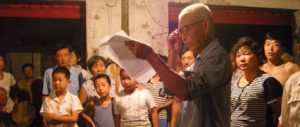In 2008, Liu Lican visited 20 “cancer villages” in 20 provinces at his own expense, seeing at first hand the villages that have been sickened by rapid economic development and environmental degradation. He has turned his experiences into a book, China’s Cancer Villages, as yet unpublished. Here, Liu talks to chinadialogue’s Zhang Yingying about his findings.
Zhang Yingying: Why did you decide to visit those 20 cancer villages?
Liu Lican: In 2006 and 2007, I read a lot of reports on environmental pollution and what affected me most was the phrase “cancer villages”. Cancer may be getting more common, but it’s frightening when you’re in a position where villages are actually being called this. And in most of the cases I looked at, there was a suspected link with pollution, so that’s an environmental issue.
I wanted to know: how are these villagers dealing with pollution and disease? Is pollution really to blame for high cancer rates? Is anyone helping them? How do they fight back or look after themselves? What has been causing all these cancer villages to appear in the last two decades? Can we do anything about it?
There were no answers available, so I decided to go and have a look for myself and learn about the situation. I knew that one person alone can do very little, but I thought that once I understood what was happening perhaps I could tell people or organisations with more resources or power – and they would be able to help.
ZY: What did you see in the cancer villages?
LL: In most cases, there is no difference in appearance between a cancer village and any other Chinese village. People live as if nothing major has happened: they work, they build houses, they go off to find jobs. But if you watch for a while, you start to notice certain characteristics. It may be that some villagers are using bottled water as they can’t drink water from wells or rivers anymore; or those living closest to the source of pollution have moved; or that the area around those sources is bare and the villagers say it has been years since anything has grown there; or maybe rivers or ponds have been ruined by pollution and are just used for dumping rubbish.
Villagers told me that pollution was causing crops to die off, animals to become infertile or deformed, fish and shrimp to disappear from rivers, children to suffer respiratory diseases. When asked, they would give several examples of serious pollution in their villages. Then, some would say they didn’t know if this pollution was connected to a nearby factory, or that they didn’t believe that my visit – anyone’s visit – would do any good.
That helplessness and lack of hope was sometimes more worrying than the environmental degradation. If everyone gives up and accepts cancer villages as a fact, we’ll just see even more of them.
ZY: Is industrial pollution the main reason for high cancer rates in these locations? And how are those cancer villages distributed?
LL: Industrial pollution is seen as the main culprit in most cancer villages, and the ones that I visited were no exception. I say “is seen as” because you need a lot of evidence to say for sure that the problems are caused by industrial pollution. We can only say that, in many villages, the main suspicion is that factory pollution has caused an increase in cancer and other diseases.
Nationwide, we can see some patterns in cancer villages. Most appeared in the mid to late 1990s and are much more frequently found in eastern and central China than in the west – most likely this is positively correlated with economic development. However, the numbers in the eastern and central regions are fairly equal.
ZY: Why do these high incidences of cancer happen in villages? How does this compare with cities?
LL: I can list several reasons for the emergence of cancer villages: general industrialisation; government failures; poor systems to protect rural people. And these three are all, in fact, the result of the pursuit of economic growth, measured only by GDP. That has brought severe environmental health issues, and particularly so in some rural areas.
High cancer rates are not just a rural phenomenon. Cancer is actually more common in cities, and the media has reported on this. The reason for paying attention to cancer villages is that, in cities, the social safety net is much stronger – healthcare and other resources are concentrated in urban areas and, if there’s a problem, it is easier to get help.
Another issue is that, when villages are polluted, in particular by factories owned by outside investors, or by the treatment of urban waste in the countryside, the villagers receive no compensation for the harm incurred. And in recent years, we have seen industry shift from the coast inland and from cities to villages, and so the harm done to rural areas has been worsening.
It is always the powerful – the parties with resources – who benefit from pollution, while vulnerable populations such as villagers suffer and struggle to get even the most basic assistance. This isn’t just the case in cancer villages; it’s the same for some urban residents. That’s why, ultimately, I raise the issue of “environmental justice”.
ZY: You visited the village of Shutangshan in Hunan province [south China]. What different roles did the villagers, the polluting businesses and the local government play in the cancer cluster there? What were the villagers calling for? And how representative is their situation of cancer villages nationwide?
LL: In general, villagers are the primary and most direct victims. The polluters often deny that they are polluting, much less that there is any link between pollution and cancer. They are either aware in advance of government checks, and so able to make necessary changes in time; or major tax contributors with powerful connections; or, when faced with incontrovertible evidence of their pollution, pay compensation for damage to land but not to health. The chances of punishment are low. Usually, local governments tend towards protecting tax-paying businesses, or have no ability to judge if cancer cases and pollution are linked. And so they are unlikely to actively pursue the villagers’ demands.
But actual situations can be complicated, as the Shutangshan case demonstrates. Some villagers persistently petitioned or sued, some hoped to get compensation, some spoke on behalf of the factory. It was hard for the villagers to get compensation – the factory would cheat them or turn them against each other. The operators would be tipped off about government checks. They delayed, denied and ignored problems.
Later, it was found that the factory had been built, despite not passing the environmental-impact assessment. The local government focused on protecting the factory and was very dismissive of reasonable requests from the villagers, and even used violence after the villagers protested. With that power imbalance, the villagers could only get compensation for minor losses, such as for dead livestock – they couldn’t exercise any more of their rights than that.
ZY: In these cancer villages, the villagers don’t sue on the basis of damage to their health, but for direct economic losses. Why is that?
LL: The relationship between pollution and disease is complex and hard to prove, and that gives government and business an excuse. Meanwhile, the villagers see that some of them get ill, while others stay healthy – and so it is also hard for them to judge the situation. The impact of industrial pollution on crops, livestock, fields, fish and buildings is easier to identify and determine, while damage to the human body is hidden. Compensation for the economic losses is hard enough to come by – suing for damage to health would be even harder.
ZY: What can be done for these cancer villages? What should the government do? What can environmental experts and organisations do?
LL: We need to help the villagers, both medically and legally, and at the very least provide some kind of explanation of what is happening. Prevention efforts in villages needs to be strengthened and government and business behaviour brought into line, which basically means GDP growth targets need to take into consideration people’s fundamental rights to life.
I went and told the villagers I met that, as an individual, there was nothing I could do, but they still spoke to me to see if I might be able to help them. If experts with specialised skills and resources could carry out an independent survey or offer aid, that would be a huge help for the villagers. Increasing knowledge of environment and health issues, boosting provision of clean drinking water, providing assistance such as legal aid, preliminary investigations and calling for outside attention – any of these actions would help.
Liu Lican is coordinator of the environmental health and climate change programme at the International Center for Communication Development (ICCD).
Zhang Yingying is assistant editor at chinadialogue’s Beijing office.
Homepage image from Greenpeace

